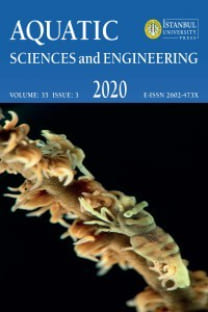KÜLTÜRÜ YAPILAN GÖKKUŞAĞI ALABALIKLARINDA (Oncorhynchus mykiss) Staphylococcus hominis subsp. hominis ENFEKSİYONU
Bu çalışmada, ticari bir gökkuşağı alabalığı işletmesinde görülen hastalık çıkışına neden olan patojen bakterilerin örnekleme yapılan balıklardan izole edilerek belirlenmesi ve çeşitli antimikrobiyal maddelere karşı duyarlılıklarının saptanması amaçlanmıştır.Hasta balıklarda; renkte koyulaşma, letarji, gözlerde ekzoftalmus ve hemoraji, ventral yüzgeçlerin dibinde hemoraji, abdominal boşlukta sıvı birikimi ve buna bağlı olarak şişkin karın, hemorajik anüs, splenomegali ve vişne kırmızısı renkte dalak, solgun veya kırmızımsı renge sahip karaciğer ve bağırsaklarda sarımsı mukoid sıvı toplanması gözlenmiştir.Çeşitli biyokimyasal testlerin ve API-Staph ve API-Zym tanı kitlerinin kullanıldığı testler sonucunda, hasta gökkuşağı alabalıklarından izole edilen suşun Staphylococcus hominis subsp. hominis olduğu saptanmıştır. Antibiyotik duyarlılık testinde tanımlanan suşun: ampisilin, basitrasin kanamisin neomisin, oksitetrasiklin polimiksin B streptomisin, sülfametoksazol/trimetoprim 19:1 antibiyotiklerine duyarlı; sefotaksim, kloramfenikol, eritromisin, flumekuin ve furazolidon antibiyotiklerine dirençli olduğu bulunmuştur.
Anahtar Kelimeler:
Staphylococcus hominis, alabalık, Oncorhynchus mykiss, hastalık
A Staphylococcus hominis subsp. hominis INFECTION IN CULTURED RAINBOW TROUT (Oncorhynchus mykiss)
The aim of this study was to identify the causative agent of a disease outbreak which occured in a commercial rainbow trout farm in Turkey and to determine antibiotic susceptibility of the isolated strains. Moribund fish showed at least one of the symptoms such as darkening color, lethargy, exophthalmos and focal hemorrhages in the eyes, hemorrhages at the base of the fins, abdominal distension due to ascitic fluid, hemorrhagic anus, splenomegaly and cherry reddish spleen, pale or reddish liver and yellowish mucoid liquid in the intestine. After performing various biochemical tests and using API-Staph identification system, the isolated strain was identified as Staphylococcus hominis subsp. hominis. Antibiotic susceptibility test showed that identified strain was sensitive to ampicillin, bacitracin, kanamycin, neomycin, oxytetracycline, polymyxin B, streptomycin, sulphamethoxazole/ trimethoprim 19:1 and was resistant to cefotaxime, chloramphenicol, erythromycin, flumequine, furazolidone antibiotics.
Keywords:
Staphylococcus hominis, trout, Oncorhynchus mykiss, disease,
___
- Austin, B. veAustin, A.D., (2007). Bacterial Fish Pathogens: Disease in Farmed and Wild Fish, 4th ed., Springer Verlag, Chichester, United Kingdom, 9781402060687.
- Baird-Parker, A.C., (1965). The classification of staphylococci and micrococci from world-wide sources, Journal of General Microbiology, 38:363-387.
- Baird-Parker, A.C., (1990). The staphylococci: an introduction, Journal of Applied Bacteriology, Suppl. 69 (1990), pp. 1S–8S.
- Baker, J.S., (1984). Comparison of various methods for differentiation of staphylococci and micrococci, Journal of Clinical Microbiology, 19: 875–879.
- Bauer, A.W., Kirby, W.M.M., Sherris, J.C., Turck, M., 1966, Antibiotic susceptibility testing by a standardized single disk method, American Journal of Clinical Pathology, 45:493-496.
- Bilgehan, H., (2004). Klinik Mikrobiyolojik Tanı, 4. Baskı, Barış Yayınları, Fakülteler Kitabevi, İzmir, 50060070057
- Çetinkaya, O. ve Şahin, A., (2005). Balıklarda Anestezi Uygulamaları ve Başlıca Anestezikler, Balık Biyolojisi Araştırma Yöntemleri, Editör: M. Karataş, Nobel Yayın Dağıtım, 237-274, 9755917578.
- Çotuk, A., (2006). Genel Mikrobiyoloji Laboratuvar Yöntemleri, Nobel Tıp Kitabevleri, 9754202907.
- De La Fuente, R., Suarez, G. ve Schleıfer, K.H., (1985). Staphylococcus aureus subsp. anaerobius subsp. nov., the causal agent of abscess disease of sheep, International Journal of Systematic Bacteriology, 35:99-102.
- Freney, J., Brun, Y., Bes, M., Meugneir, H., Grimont, F., Grimont, P.A.D., Nervi, C. veFleurette, J., (1988). Staphylococcus lugdunensis sp. nov. and Staphylococcus schleiferi sp. nov., two species from human clinical specimens, International Journal of Systematic Bacteriology, 38:168-172.
- Gil, P., Vivas, J., Gallardo, C.S. ve Rodriguez, L.A., (2000). First isolation of Staphylococcus warneri, from diseased rainbow trout, Oncorhynchus mykiss (Walbaum), in Northwest Spain, Journal of Fish Diseases, 23, 295-298.
- Götz, F., Bannerman, T. ve Schleifer, K.H, (2006). Chapter 1.2.1: The genera Staphylococcus and Macrococcus, In: The prokaryotes: a handbook on the biology of bacteria Third edition, vol. 4. Chief edt. M. Dworkin, edts. S. Falkow, E. Rosenberg, K.H. Schleifer, E. Stackebrandt, Springer Publisher, New York, 0387254935.
- Hàjek, V., (1976).Staphylococcus intermedius. a new species isolated from animals, International Journal of Systematic Bacteriology, 26:401- 408.
- Holt, J.G., (1994). Bergey’s Manual of Determinative Bacteriology (9th ed), Lippincott Williams & Wilkins, Philadelphia, 9780683006032.
- Huang, S.L., Chen, W.C., Shei, M.C., Liao, I.C. veChen, S.N., (1999). Studies on epizootiology and pathogenicity of Staphylococcus epidermidis in Tilapia (Oreochromis spp.) cultured in Taiwan, Zoological Studies, 38(2): 178-188.
- Igimi, S., Kawamura, S., Takahashi, E. veMitsuoka, T., (1989). Staphylococcus felis, a new species from clinical specimens from cats, International Journal of Systematic Bacteriology, 39:373-377.
- Inglis, V., Roberts, R.J. ve Bromage, N.R., (1993). Bacterial Diseases in Fish, Blackwell Scientific Publications, London, 9780632034970.
- Kloos, W.E. veSchleıfer, K.H., (1975). Isolation and characterization of staphylococci from human skin. II. Descriptions of four new species: Staphylococcus warneri, Staphylococcus capitis, Staphylococcus hominis, and Staphylococcus simulans, International Journal of Systematic Bacteriology, 25:62-79.
- Kubilay, A. veUluköy, G., (2004). First isolation of Staphylococcus epidermidis from cultured gilthead sea bream (Sparus aurata) in Turkey, Bulletin of the European Association of Fish Pathologists, 24(3): 137-143.
- Kusuda, R. veSugiyama, A., (1981). Studies on the characters of Staphylococcus epidermidis isolated from diseased fishes − I. On the morphological, biological and biochemical properties, Fish Pathology, 16: 15-24.
- Timur, G. ve Akayli, T., (2003). First study of Staphylococcosis in farmed rainbow trout (Oncorhynchus mykiss W.1792) fry in Turkey, International Symposium of Fisheries and Zoology, 23-26 October 2003 Istanbul, p 67-79.
- Shah, K.L. ve Tyagi, S.C., (1986). An eye disease in silver carp Hypophthalmichthys molitrix held in tropical ponds associated with the bacterium Staphylococcus aureus, Aquaculture, 55: 1-4.
- Varaldo, P.E., Kilpper-Bälz, R., Biavasco, F., Satta, G. ve Schleifer, K.H., (1988). Staphylococcus delphini sp. nov., a coagulase-positive species isolated from dolphins, International Journal of Systematic Bacteriology, 38: 436–439.
- Varvarigos, P., (2008). Gram positive coccobacteria (Micrococcaceae, Streptococcaceae) causing systemic disease in intensively farmed fish, Brief review [online], http://www.vetcare.gr/Gram_positive_cocci.htm [Ziyaret Tarihi: 27.10.2008].
- Wang, W.-S., Chang, Y.-C., Shieh, M.-T. ve Lin, C.-C., (1996). Staphylococcus epidermidis and cestode infection of cultured grass carp (Ctenopharyngodon idella) in Taiwan, Reports on Fish Disease Research, 17, 57-63.
- Whitman, K.A., (2004). Finfish and Shellfish Bacteriology Manual: Techniques and Procedures, Iowa state press, USA, 0-8138-1952-0.
- Yayın Aralığı: Yılda 4 Sayı
- Başlangıç: 1987
- Yayıncı: İstanbul Üniversitesi
